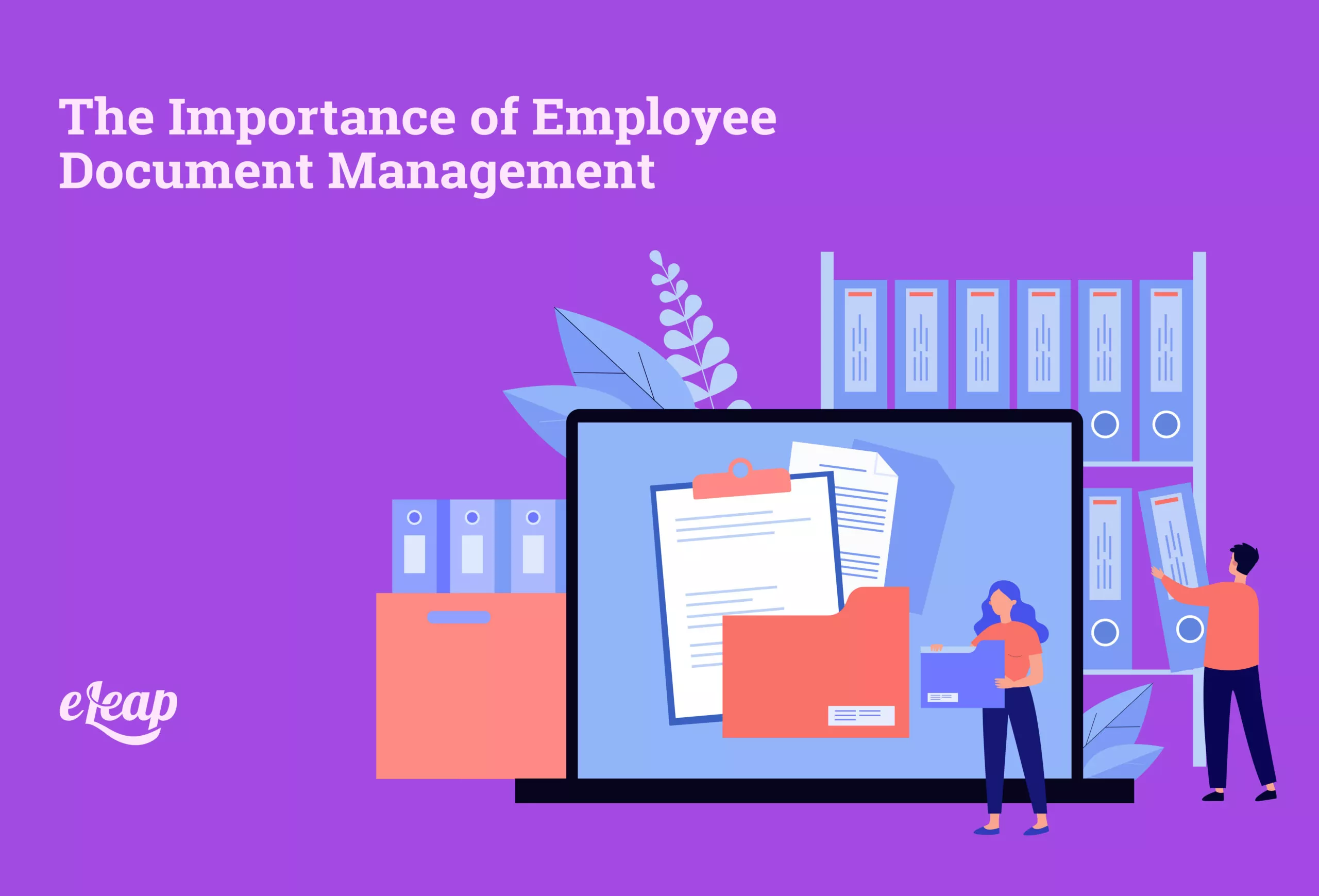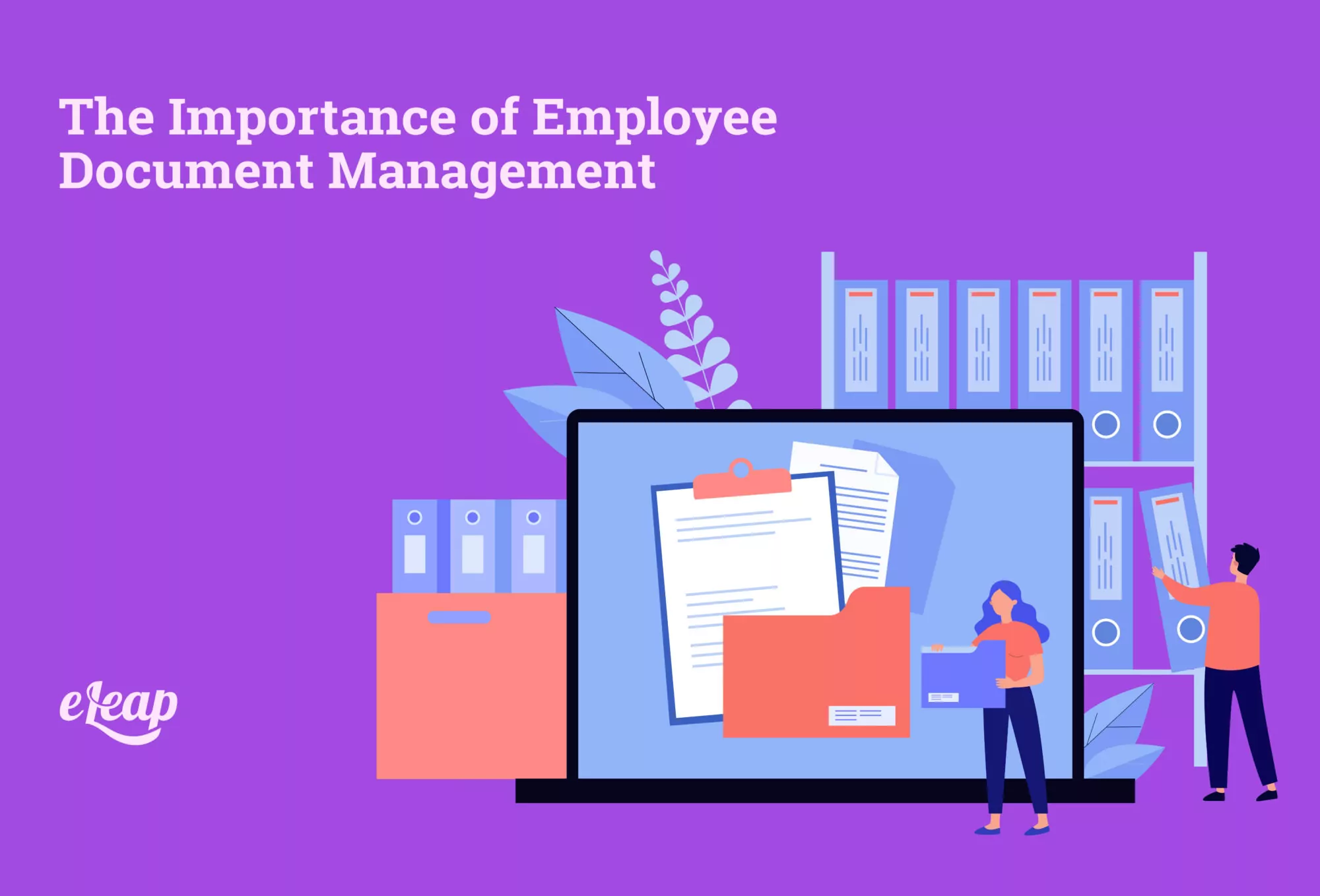The Importance of Employee Document Management

Effective employee document management is critical for organizations of all sizes, particularly in the United States, where legal regulations around documentation are stringent. Proper records management ensures compliance with state and federal laws, streamlines internal operations, fosters transparency, and reduces the risk of legal challenges. See how eLeaP®’s Performance Management Platform helps you apply these insights to drive better results.
This article delves into the importance of managing employee documents correctly, providing a comprehensive look at best practices, legal compliance, and the tools available to HR departments for efficient document management.
Key Types of Employee Documents You Must Manage
First, explore the essential categories of employee documents that should be meticulously managed. Proper documentation helps organizations to protect themselves legally, monitor employee progress, and maintain a smooth workflow.
Personal and Basic Information
Personal and basic employee details form the foundation of any employee record. These include contact information, emergency contacts, and critical demographic data. While this information may seem simple, keeping it up-to-date is crucial for communication, emergency responses, and ensuring compliance with laws such as the Family Medical Leave Act (FMLA).
In an emergency, quick access to accurate contact details is essential. Moreover, this data is often requested by government agencies or during audits, and failure to provide it can result in penalties.
Recruitment and Onboarding Documents
The recruitment process generates many documents that should be securely stored in an employee’s file. These documents help understand the candidate’s qualifications and serve as proof of compliance with hiring laws.
Key documents include job applications, resumes, interview notes, and offer letters. Additionally, onboarding materials such as signed contracts, tax forms like the W-4, and benefits enrollment forms should be kept. Properly managing these documents ensures the hiring process is legally compliant and provides a clear record of the initial employment terms.
Employment Agreements and Legal Contracts
Employment contracts form a legal foundation between the employer and the employee. These include non-disclosure agreements (NDAs), non-compete agreements, and any union contracts that might be in place. Tracking these agreements is necessary to protect sensitive business information and ensure both parties understand their rights and obligations.
Tracking these agreements is essential for compliance for businesses that operate in multiple states or industries with specific rules (e.g., healthcare or finance). For instance, a non-compete agreement should be reviewed regularly to ensure it’s enforceable and the employer has a record of the agreed-upon terms.
Performance and Development Documentation
Employee performance documentation is integral to any long-term employee-management strategy. This process includes performance reviews, feedback, and records of training or development programs. Regular performance evaluations help managers identify strengths and areas for improvement and provide legal protection if disciplinary action is ever needed.
Training records, such as certifications, safety training, and professional development courses, must be adequately documented to ensure employees meet industry standards and regulatory requirements.
Moreover, documentation of disciplinary actions is just as necessary as performance reviews. It provides a record in case the employer needs to prove that it made efforts to support or correct an employee’s behavior.
Payroll, Compensation, and Benefits Records
Payroll records are essential for calculating wages and for tax purposes. The Internal Revenue Service (IRS) requires employers to maintain payroll records for a certain period in the United States.
Employee compensation documents typically include wage and salary information, pay stubs, tax withholding records, and year-end forms such as the W-2. Benefits records, including enrollment forms for health insurance, retirement plans, and other benefits, are also essential to track. Mismanagement of these documents could result in penalties and disputes with employees over their compensation or benefits.
Termination and Exit Documentation
When an employee leaves a company, whether voluntarily or involuntarily, certain documents are required to finalize their employment. This process includes resignation or termination letters, exit interview forms, and a final performance review. These documents help ensure that the process is handled legally and that the employer and the employee are clear about any post-employment obligations.
Exit documentation is also vital for ensuring compliance with severance agreements, retirement plan distribution, and the return of company property. Mismanagement at this stage could lead to legal disputes or even wrongful termination claims.
Legal and Compliance Requirements in Document Management

One of the most critical aspects of managing employee documents is ensuring compliance with federal and state regulations. Employers must adhere to various rules to avoid penalties, from retaining documents at the right time to protecting employee privacy.
Understanding Legal Obligations and Retention Policies
The first step in managing employee documents is understanding what is legally required. In the U.S., employers must keep certain records for specific periods. For instance, under the Fair Labor Standards Act (FLSA), payroll records must be kept for at least three years. Other documents, like I-9 forms, must be retained for at least three years from the date of hire or one year after employment ends, whichever is later.
The Equal Employment Opportunity Commission (EEOC) requires that employee records related to discrimination be kept for a minimum of one year after the record is made. Understanding these retention schedules and ensuring compliance can help avoid costly mistakes.
How Long Should Employee Documents Be Stored?
Retention policies vary by document type and industry, so staying current with the laws that apply to your business is essential. Industry-specific guidelines may require extended retention periods, particularly in regulated fields like healthcare, where employee health records must be retained for many years.
The best approach is to maintain a clear and accessible record retention schedule, which should be regularly reviewed to ensure that all documents are disposed of properly when no longer needed. If documents are destroyed prematurely, the wrong approach could lead to excessive document storage costs, potential security breaches, or even legal risks.
Employee Privacy and Confidentiality Laws
With the rise of data protection laws such as the General Data Protection Regulation (GDPR) and the Health Insurance Portability and Accountability Act (HIPAA), maintaining the confidentiality of employee records has become more critical than ever. These laws dictate how personal data should be handled, stored, and shared.
Employers must ensure that personal information like Social Security numbers, health data, and financial information is securely stored and accessible only to authorized personnel. Non-compliance with privacy laws can lead to serious consequences, including hefty fines.
Best Practices for Efficient Employee Document Management
Maintaining a well-organized employee document system isn’t just about compliance; it’s about making your HR department more efficient. Implementing best practices will ensure employee data is easily accessible, securely stored, and regularly updated.
Organizing Employee Documents for Accessibility
Creating an organized system is one of the first steps in efficient document management. Documents should be categorized and stored to make them easy to locate when needed. Consider creating separate folders for personal information, job application documents, performance evaluations, and benefits information.
The system should also provide easy access for authorized personnel. This stage could be achieved using a cloud-based storage solution or digital HR software such as eLeaP, which helps keep employee documents organized and readily available for HR departments. Whether using physical or digital files, accessibility is key to managing records efficiently.
The Role of HR Software in Document Management
HR software has revolutionized the way businesses handle employee records. Tools like eLeaP allow enterprises to automate document management, ensuring records are appropriately stored, indexed, and easily searchable.
Incorporating software can help reduce the risk of data entry errors, speed up document retrieval, and improve security by protecting sensitive data. Modern HR systems can support compliance by offering built-in reminders for document retention timelines.
Automation and Workflow for Document Collection
Another essential best practice is automating the document collection process. By automating the collection of documents like tax forms, health insurance enrollments, and performance reviews, HR departments can reduce administrative workloads and eliminate human errors.
Automation tools integrated with HR software can automatically generate reminders for document updates or completion, ensuring nothing is missed. This workflow also reduces the time it takes to onboard new employees or process offboarding paperwork, saving valuable time for HR professionals.
Regular Audits and Document Reviews
Document audits should be a regular part of any HR department’s responsibilities. Auditing employee records ensures that everything is current and complies with retention policies. This process allows organizations to identify outdated documents that should be discarded and ensure that essential records are maintained in the correct format.
Regular reviews also help ensure that employee documents are secure and have not been tampered with or mishandled.
Common Mistakes to Avoid in Employee Document Management
Despite the best intentions, companies sometimes make mistakes when managing employee documents. These errors can lead to legal liabilities or operational inefficiencies.
Mishandling Sensitive Information
One of the most critical errors employers can make is mishandling sensitive employee information. Given increasing concerns about data breaches and identity theft, storing and transferring sensitive data using secure systems and encryption is vital. Sharing private employee information without proper consent or safeguards could expose the company to legal action.
Inconsistent or Poor Organization
Disorganization in employee files is another common mistake. It can be challenging to track employee records effectively if they are not organized according to clear categories. This stage can lead to wasted time, missed deadlines, and potential compliance violations. An efficient system ensures that files are easy to access and that records are current and complete.
Failing to Update Documents Regularly
Failure to keep employee records current is a common issue, especially regarding performance reviews, contact information, or certifications. Storing outdated documents can lead to inaccurate information and potentially put the company at risk in case of an audit.
The Future of Employee Document Management: Trends to Watch
As businesses continue to digitize and automate operations, the future of employee document management is evolving. The following trends are shaping the way organizations approach document storage and management.
The Move to Fully Digital Systems
More businesses are adopting digital systems for document management to reduce paperwork and improve accessibility. Cloud-based platforms provide employees with self-service access to their documents, offering flexibility and reducing the need for physical storage space.
AI and Machine Learning in Document Management
Advances in artificial intelligence (AI) are beginning to revolutionize document organization. AI algorithms can automatically tag and categorize documents, reducing human error and improving searchability.
Employee Self-Service Portals and Document Access
Another growing trend is empowering employees to manage their documents through self-service portals. These portals allow employees to access, update, and track their records, giving them more control over their data and reducing administrative burdens.
Conclusion
Effective employee document management is essential for compliance, efficiency, and legal protection. Businesses can build a successful system by understanding the importance of document types, legal obligations, and best practices.
Utilizing modern tools like eLeaP can streamline the process, ensuring your organization remains compliant and efficient. Investing in sound document management practices will save time, reduce risk, and support your company’s long-term success.